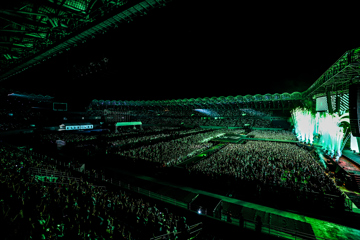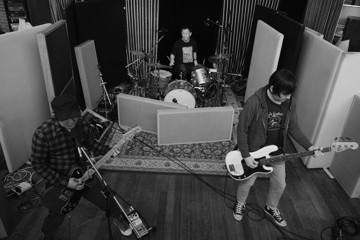Film Carew: The Hobbit: The Battle Of The Five Armies
Carew also tackles St. Vincent, The Water Diviner, Mr. Turner, Keep On Keepin’ On, A Girl Walks Home Alone At Night
The Hobbit: The Battle of the Five Armies

Thank fuck that’s over. The Hobbit: The Battle Of The Five Armies marks the final film - well, at least for now - in Peter Jackson’s endless Middle Earth saga; the third film in a trilogy of prequels that sought to turn a slender 250-page kid’s-book into seven hours of CGI 3D dreariness.
#OneLastTime promises the PR-mandated hashtag, as if the even the best thing spin-doctors can think to say is that our collective cinematic suffering is coming to a grateful end. Yet, first Jackson has one last gift for all those devoted fans of the series: far-and-away the worst installment yet.
Don't miss a beat with our FREE daily newsletter
It begins where Episode 2: The Rise Of The 1-Star Reviews pressed pause, with the dragon blessed with Benedict Cumberbitch diction flying off to blow awful-looking CGI flames at an awful-looking CGI village-on-the-water that soon catches on CGI fire. It plays exactly like the climax to the last movie held over: within ten minutes, Smaug’s slain; the day saved.
His death inspires a gold-rush on his Scrooge-McDuck-money-pit lair, with Dwarves and Elves and Humans and Orcs all marching to an inevitable confrontation, signposted in the film and joylessly portended throughout.
“These soldiers are bred... for war” bellows Ian McKellan; “These bats are bred for one purpose... for war!” monotones the wooden marionette we call Orlando Bloom. And, with a slog and a plod - the only moments of mirth come from derisively laughing at the film’s awfulness; especially Richard Armitage’s hammed-up slide into ‘Dragon Sickness’, which is definitely at its best/worst when he’s lost in a Flintstones Chewable Morphine dialogue loop - we slowly march towards the big battle-scene finale.
 There, pixels collide with other pixels, principal cast members are saved from certain death time and again, orcs created to be killing-machines somehow turn hapless fodder in the heat of battle, 12 dwarves turn the tide of a battle in its thousands, and, eventually, after two bum-numbing hours, good triumphs over evil. The final primary-school lesson is that, get this, greed is bad: “if more people valued home above gold, this world would be a merry place” says a dwarf on his deathbed, whispering profound sweet nothings with his dying breaths.
There, pixels collide with other pixels, principal cast members are saved from certain death time and again, orcs created to be killing-machines somehow turn hapless fodder in the heat of battle, 12 dwarves turn the tide of a battle in its thousands, and, eventually, after two bum-numbing hours, good triumphs over evil. The final primary-school lesson is that, get this, greed is bad: “if more people valued home above gold, this world would be a merry place” says a dwarf on his deathbed, whispering profound sweet nothings with his dying breaths.
Throughout, there’s an absolute absence of suspense: this is the placeholder finale in a series that is itself a placeholder; a host of humdrum prequels whose only effect has been to diminish the memory of the Lord Of The Rings movies.
The worst moments in The Battle Of The Five Armies come when Jackson is blatantly foreshadowing the later series, as when Lee Pace tells Bloom to go look for a man resembling Viggo Mortensen so as to have future adventures, somehow oblivious to the fact that Bloom looks roughly 20 years older - thicker of neck and jowlier of face - than he will next time he appears on screen in Fellowship Of The Ring; elven eternal-life not precluding Matthew-Perry-on-Friends style gain/loss cycles.
What we’re left with is a film that cannot, for a single frame, justify its own existence. For a parable on greed, its own greed is stupefying; this entire Hobbit series a symbol of Hollywood’s rapacious appetite for guaranteed profits and franchise branding installments.
Just as George Lucas effectively ruined his own saga-of-a-generation by returning to the bank for a trio of artistically-inert prequels, so too has Jackson done the same; he squeezing the fruit of childhood innocence for every last droplet of juice.
St. Vincent

 Non-spoiler alert: as the closing credits to St. Vincent roll, they do so over top of a long, unbroken take of Bill Murray watering plants, sitting in his deckchair, hosing a table clean, all as he sings along to Shelter From The Storm. It’s an incidental extra that taps into the film’s raison d’être: this a film built for all those who worship at the altar of Murray.
Non-spoiler alert: as the closing credits to St. Vincent roll, they do so over top of a long, unbroken take of Bill Murray watering plants, sitting in his deckchair, hosing a table clean, all as he sings along to Shelter From The Storm. It’s an incidental extra that taps into the film’s raison d’être: this a film built for all those who worship at the altar of Murray.
He plays an irascible, drunken, chain-smoking Vietnam vet who begins the film with one of those days-from-hell bottoming-outs: he’s broke, his bank account overdrawn; he’s refused service at his local watering-hold, too drunk to even drown his sorrows; and, eventually, he crashes his car and crashes out on the floor.
He wakes up to find himself with new neighbours, Melissa McCarthy and son Jaeden Lieberher, and soon finds himself looking after Lieberher for $12 an hour, teaching him the ways of racetrack gambling, Abbott & Costello movies, and standing up to bullies.
It’s, in many ways, a minor crowdpleaser, but Theodore Melfi’s script achieves its modest goals ably. Murray stumbles through the film, never reduced to one thing: he hero, villain, good guy, bad; a mess who’s either dragging Lieberher down with him, or teaching him sound lessons in the school of hard knocks.
The narrative is handballed to McCarthy’s struggling single mother, a CAT-scan technician in the middle of a contentious separation, adding perspective; and every time Chris O’Dowd comes on screen, the film’s blessed with his warmth and wit. When the whole culminates in a feelgood finale in which the whole cast comes together to warmly applaud Murray, it’s horrifyingly sentimental, but also undeniably effective; there definite voodoo at work as Melfi summons real feeling despite the transparency of the emotional button-pushing.
The Water Diviner

In the most Russell Crowe moment of Russell Crowe’s directorial debut, Our Rusty - or New Zealand’s, I guess - teaches a trainful of Turkish soldiers how to play cricket (“everyone plays,” he says, of cricket in Australia), then wields the willow to help his newfound friends escape an ambush by a phalanx of swarthy Greek villains, music pumping like an ’80s action-movie all the while.
Crowe’s film, The Water Diviner, is a spiritual successor to Gallipoli, a well-meaning history lesson out to illumine the ANZAC mythos with both fact and fantasy, a homegrown Hollywood star strutting through frame, embodying dogged determination, heroism, and grief in the form of one man. And what a man! Crowe plays the titular figure, whose ability to find subterraneous water with a pair of sticks grants him the power of fateful dream-visions and Sherlocking sleuth skills; his quivering hands and mystical intuition allowing him to summon history in flashes of faux-grainy war-is-hell montages that, soon, balloon out to tragic, slowly-revealing-the-secrets back-story.
 Crowe’s three sons all died in Gallipoli, and he arrives in Istanbul hoping to find their bodies, his goal to give them a proper burial back in their dustbowl outback home. On landing, he meets Olga Kurylenko, the Ukrainian super-model cast as sexy single Turkish mother; her initial hatred of this foreign brute, a white man whose country killed her husband, soon melting as Crowe turns on all his Rabbitoh charms.
Crowe’s three sons all died in Gallipoli, and he arrives in Istanbul hoping to find their bodies, his goal to give them a proper burial back in their dustbowl outback home. On landing, he meets Olga Kurylenko, the Ukrainian super-model cast as sexy single Turkish mother; her initial hatred of this foreign brute, a white man whose country killed her husband, soon melting as Crowe turns on all his Rabbitoh charms.
Rusty’s soon off to the site of future bogan-tourist binge-drinking, landing in Gallipoli and falling in with a joint post-war effort, lead by Jai Courtney’s ever-measured Colonel and Yilmaz Erdogan’s Turkish officer, to identify the remains of the endless dead buried ad-hoc on the blood-strewn battlegrounds.
To gin up the tension, Crowe can’t search in peace, but has to have people on his tail: the English military (as with Gallipoli, the English are heartless bureaucrats who decry Crowe’s Australian emotions), invading Greeks, and Kurylenko’s outraged relatives all, as the football commentators like to say, “on his hammer”.
The Water Diviner attempts to paint a portrait of the complex politics of occupied lands, to give as much respect to the Ottoman Empire as to the ANZAC myth, to try and author a critique of war (“I filled their head with heroic nonsense of God and King and Country,” Crowe laments, culpable in the downfall of his own children) whilst heroising those who participate in it. But its more thoughtful moments are lost to the need to push the pace, to introduce the action-movie set-pieces of fist-fights and foot-chases, and to curry the matinée melodrama and old-fashioned derring-do on which the film truly hangs its hat.
There’s a sober history lesson in here, but The Water Diviner largely feels like a film about how great Russell Crowe thinks Russell Crowe is: he the ideal man to win the girl, defy the odds, right wrongs, and bring us all, 100 years on, dramatised National Closure.
Mr. Turner

“When I peruse the looking-glass, I see a gargoyle,” admits Timothy Spall’s JMW Turner, in a piece of self-deprecation floated as part of an unexpected seduction. It’s the one moment, in Mike Leigh’s 150-minute portrait of the titular artist, in which the subject admits to sharing the view of so many others: that this man is a monster.
Spall plays Turner as a bear-with-a-sore head, a succession of gruff growls and wearied brows, looking as if perpetually hungover, longing to return “into the arms of Morpheus”. He’s socially inept, but ever so adept with a brush, Turner’s canvases —his endless washed-out, dreamlike epics of shipwrecks and high-seas battles— earning him entry into reaches of English society far beyond his station.
At home he may sullenly bang the chambermaid and grunt his way through days, but in the court of wealthy benefactors, and amongst his peers in the Royal Academy Of Arts, he comes to life; gladhanding with his homies from the art establishment (“Mr. Carew!” he shouts, at one point; perhaps for the first-time-ever in cinema), and providing expert advice in light, contrast, detail; especially in a memorable single-take where the collective Academy prepares for a presentation to the King.
 Spall’s a lower-class drudge with lower-class methods —spit, snot, cream, and egg all upon his palette— which both horrifies and delights the giggling upper-crust ladies and esteemed gentleman who’ve let this brute in the house.
Spall’s a lower-class drudge with lower-class methods —spit, snot, cream, and egg all upon his palette— which both horrifies and delights the giggling upper-crust ladies and esteemed gentleman who’ve let this brute in the house.
There are elements here that, in other hands, would feel hoary: Turner the before-his-time trailblazer confounding archaic convention; Turner the artist-as-genius who doubled as insufferable prick; Turner the drunk who denied his own paternity. But Leigh has little interest in delivering a conventional biopic, even if he employs many of their narrative conventions.
Befitting his socio-realist ways, Leigh seeks to summon an entire milieu, to recreate a distant day outside of the drawing-rooms of BBC dramas; his ear for anachronism and colloquial expression remaining a delight throughout. He also sees the big picture —the death of Enlightenment Britain, the rise of the Industrial Revolution— without ever needing to beat an audience over the head with the themes; even the arrival of the daguerrotype, a sure symbol for the imminent irrelevance of figurative painters.
But Leigh also shows his hero (or anti-hero) as being a man of almost innate photographic sensibility: Turner obsessed with the passage of the sun and its effects on colour; he, in his own way, painting with light.
Keep On Keepin’ On

Alan Hicks’ picture begins as if it’ll be another rockumentary hammered from the same tired template: a shrine to an aging great —here, jazz lifer Clark Terry— coming through childhood snapshots, testimonialising talking-heads, and static presentation.
But then time and fate intervene, and what could’ve been a mere DVD-bonus-disc pushes at the boundaries imposed on it; becoming something bigger, greater, more human; a jazz film that’s filled with the music but is never about it. As the years press on —across 86 minutes— the ‘story’ of Terry gives way to life as lived; the grand old trumpeter, health failing, days on Earth dwindling, forming an intense friendship with Justin Kauflin, a blind piano prodigy who he, initially, seeks only to mentor.
The pair may initially seem like an odd couple —a 90-something African-American and a 20-something Asian-American— but they’re united in both disability and ability, their afflictions standing in stark contrast to their musical dexterity. At first, the pair discuss only music, but soon they become figures of moral support, mirroring images of sunny disposition and persistent optimism.
Where most music documentaries proudly posit the idea that what matters most is the jams a late artist leaves behind, Hicks, instead, suggests it’s the people they’ve touched.
A Girl Walks Home Alone At Night

Ana Lily Amirpour’s debut film, A Girl Walks Home Alone At Night —screening, in Melbourne, at ACMI— works as a veritable companion piece to Jim Jarmusch’s Only Lovers Left Alive, even if, stylistically, it’s steeped in Jarmusch’s early films.
In an industrial wasteland of glowing power-plants, pumping oil derricks, and fluorescent lights buzzing and bleeding through every frame, the lonesome denizens of the night are haunted by Sheila Vand’s vampire.
She skateboards through the empty streets, chador flowing behind her like a cape, stalking men who walk home alone at night; an avenging angel out to suck the blood of local lowlifes, an anti-heroine taking a table-turning bite out of the patriarchy. This non-city is rust belt America posing as Bad City, Iran; a symbolic nowhere in which Vand and Arash Marandi are drawn slowly together, the last lovers in a ghost-town of hate. The mythical title of its town nods to one of the films key influences, Sin City, its high-key black-and-white style drawn from comic-books, German expressionism, the nouvelle vague, neo-noir, Spaghetti Westerns, and David Lynch’s nocturnal nightmares.
But Jarmusch lands closest to home not just for the Stranger Than Paradise palette, but for the way Amirpour, too, fetishises old pop-songs and faded formats, the stilled, deadpan drama coming to life —and summoning emotion— only when it drops the needle on a record.







